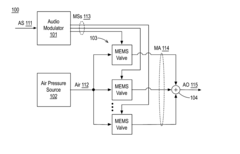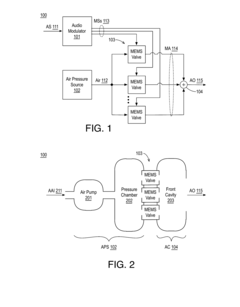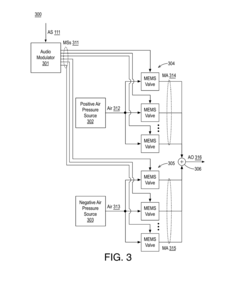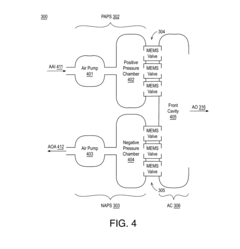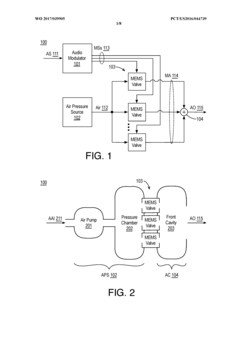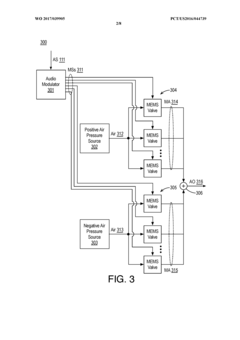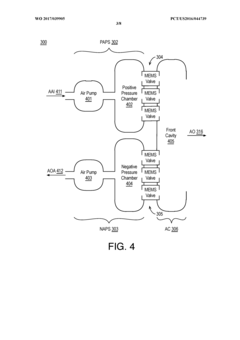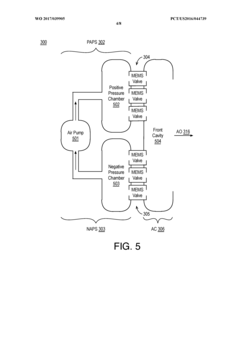LDAC and Its Future in Audiophile Devices
JUL 4, 20258 MIN READ
Generate Your Research Report Instantly with AI Agent
Patsnap Eureka helps you evaluate technical feasibility & market potential.
LDAC Technology Overview and Objectives
LDAC, developed by Sony in 2015, represents a significant advancement in wireless audio technology. This codec aims to deliver high-resolution audio over Bluetooth connections, addressing the growing demand for superior sound quality in wireless devices. LDAC's primary objective is to overcome the limitations of traditional Bluetooth audio codecs by offering higher bitrates and improved audio fidelity.
The technology behind LDAC has evolved from earlier attempts to enhance Bluetooth audio quality. It builds upon the foundation laid by previous codecs such as SBC (Sub-band Coding) and aptX, pushing the boundaries of what is possible in wireless audio transmission. LDAC's development was driven by the increasing popularity of high-resolution audio formats and the audiophile community's desire for lossless wireless playback.
LDAC's technical goals are ambitious and multifaceted. Firstly, it aims to support bitrates of up to 990 kbps, significantly higher than standard Bluetooth codecs. This increased bandwidth allows for the transmission of audio data with minimal compression, preserving more of the original recording's detail and nuance. Secondly, LDAC strives to maintain compatibility with a wide range of devices while offering scalable performance based on connection quality and device capabilities.
Another key objective of LDAC is to minimize latency, a critical factor for audio-visual synchronization in applications such as gaming and video playback. By optimizing its encoding and decoding processes, LDAC seeks to reduce the delay between audio transmission and playback, enhancing the overall user experience.
The technology also aims to address power consumption concerns, a perennial challenge in mobile and wireless devices. LDAC's developers have focused on creating efficient encoding algorithms that balance high-quality audio transmission with reasonable battery life, making it suitable for everyday use in portable devices.
Looking towards the future, LDAC's objectives include wider adoption across the audio industry and continuous improvement of its core technology. As the audiophile market grows and consumer expectations for wireless audio quality increase, LDAC positions itself as a leading solution for high-fidelity Bluetooth transmission. The technology's roadmap likely includes further refinements in bitrate efficiency, expanded device compatibility, and potential integration with emerging wireless standards to ensure its relevance in the evolving audio landscape.
The technology behind LDAC has evolved from earlier attempts to enhance Bluetooth audio quality. It builds upon the foundation laid by previous codecs such as SBC (Sub-band Coding) and aptX, pushing the boundaries of what is possible in wireless audio transmission. LDAC's development was driven by the increasing popularity of high-resolution audio formats and the audiophile community's desire for lossless wireless playback.
LDAC's technical goals are ambitious and multifaceted. Firstly, it aims to support bitrates of up to 990 kbps, significantly higher than standard Bluetooth codecs. This increased bandwidth allows for the transmission of audio data with minimal compression, preserving more of the original recording's detail and nuance. Secondly, LDAC strives to maintain compatibility with a wide range of devices while offering scalable performance based on connection quality and device capabilities.
Another key objective of LDAC is to minimize latency, a critical factor for audio-visual synchronization in applications such as gaming and video playback. By optimizing its encoding and decoding processes, LDAC seeks to reduce the delay between audio transmission and playback, enhancing the overall user experience.
The technology also aims to address power consumption concerns, a perennial challenge in mobile and wireless devices. LDAC's developers have focused on creating efficient encoding algorithms that balance high-quality audio transmission with reasonable battery life, making it suitable for everyday use in portable devices.
Looking towards the future, LDAC's objectives include wider adoption across the audio industry and continuous improvement of its core technology. As the audiophile market grows and consumer expectations for wireless audio quality increase, LDAC positions itself as a leading solution for high-fidelity Bluetooth transmission. The technology's roadmap likely includes further refinements in bitrate efficiency, expanded device compatibility, and potential integration with emerging wireless standards to ensure its relevance in the evolving audio landscape.
Market Analysis for High-Resolution Audio
The high-resolution audio market has experienced significant growth in recent years, driven by increasing consumer demand for superior sound quality and the proliferation of advanced audio technologies. This segment caters to audiophiles and music enthusiasts who seek a more immersive and authentic listening experience. The market encompasses various products, including high-end headphones, digital-to-analog converters (DACs), portable music players, and streaming services that support high-resolution audio formats.
Market research indicates that the global high-resolution audio market is expected to continue its upward trajectory. Factors contributing to this growth include the rising popularity of lossless audio streaming services, advancements in audio compression technologies like LDAC, and the increasing adoption of high-resolution audio in smartphones and other portable devices. The market is also benefiting from the growing trend of home audio setups and the resurgence of vinyl records, which has rekindled interest in high-fidelity sound reproduction.
In terms of regional distribution, North America and Asia-Pacific are the leading markets for high-resolution audio products. The United States, in particular, has a strong base of audiophile consumers willing to invest in premium audio equipment. In Asia, countries like Japan and South Korea are at the forefront of high-resolution audio technology development and adoption. Europe is also showing steady growth, with countries like Germany and the UK demonstrating increasing demand for high-end audio products.
The competitive landscape of the high-resolution audio market is characterized by a mix of established audio equipment manufacturers and innovative startups. Key players include Sony, with its LDAC technology, as well as other major brands like Sennheiser, Bowers & Wilkins, and Astell&Kern. These companies are continuously innovating to improve audio quality and introduce new features that appeal to discerning audiophiles.
Consumer trends in the high-resolution audio market reveal a growing interest in wireless solutions that do not compromise on sound quality. This has led to increased demand for technologies like LDAC, which offers near-lossless audio transmission over Bluetooth. Additionally, there is a rising preference for multi-functional devices that combine high-resolution audio capabilities with other features such as noise cancellation and smart assistant integration.
Looking ahead, the high-resolution audio market is poised for further expansion as technology continues to evolve. The integration of artificial intelligence for personalized audio experiences and the development of more efficient audio codecs are expected to drive future growth. Moreover, as awareness of high-resolution audio increases among mainstream consumers, the market is likely to see broader adoption beyond the traditional audiophile segment.
Market research indicates that the global high-resolution audio market is expected to continue its upward trajectory. Factors contributing to this growth include the rising popularity of lossless audio streaming services, advancements in audio compression technologies like LDAC, and the increasing adoption of high-resolution audio in smartphones and other portable devices. The market is also benefiting from the growing trend of home audio setups and the resurgence of vinyl records, which has rekindled interest in high-fidelity sound reproduction.
In terms of regional distribution, North America and Asia-Pacific are the leading markets for high-resolution audio products. The United States, in particular, has a strong base of audiophile consumers willing to invest in premium audio equipment. In Asia, countries like Japan and South Korea are at the forefront of high-resolution audio technology development and adoption. Europe is also showing steady growth, with countries like Germany and the UK demonstrating increasing demand for high-end audio products.
The competitive landscape of the high-resolution audio market is characterized by a mix of established audio equipment manufacturers and innovative startups. Key players include Sony, with its LDAC technology, as well as other major brands like Sennheiser, Bowers & Wilkins, and Astell&Kern. These companies are continuously innovating to improve audio quality and introduce new features that appeal to discerning audiophiles.
Consumer trends in the high-resolution audio market reveal a growing interest in wireless solutions that do not compromise on sound quality. This has led to increased demand for technologies like LDAC, which offers near-lossless audio transmission over Bluetooth. Additionally, there is a rising preference for multi-functional devices that combine high-resolution audio capabilities with other features such as noise cancellation and smart assistant integration.
Looking ahead, the high-resolution audio market is poised for further expansion as technology continues to evolve. The integration of artificial intelligence for personalized audio experiences and the development of more efficient audio codecs are expected to drive future growth. Moreover, as awareness of high-resolution audio increases among mainstream consumers, the market is likely to see broader adoption beyond the traditional audiophile segment.
LDAC Technical Challenges and Limitations
LDAC, while a significant advancement in Bluetooth audio codecs, faces several technical challenges and limitations that impact its performance and adoption in audiophile devices. One of the primary challenges is the codec's high computational requirements. LDAC's complex encoding and decoding processes demand substantial processing power, which can lead to increased power consumption and potential heat generation in portable devices. This issue is particularly pronounced in smaller form factor devices, where battery life and thermal management are critical concerns.
Another limitation of LDAC is its sensitivity to signal interference and connection stability. The codec's high bitrate transmission requires a robust and consistent Bluetooth connection. In environments with significant electromagnetic interference or physical obstacles, LDAC may struggle to maintain its optimal performance, potentially resulting in audio dropouts or quality degradation. This sensitivity can be particularly problematic in urban environments or crowded spaces where multiple wireless signals compete.
LDAC also faces challenges in terms of hardware compatibility. While the codec has been adopted by various manufacturers, it is not universally supported across all Bluetooth-enabled devices. This lack of ubiquity can limit the codec's effectiveness in the broader audiophile ecosystem, as users may find their high-quality LDAC-enabled source devices incompatible with certain headphones or speakers.
The codec's variable bitrate nature, while generally beneficial, can introduce inconsistencies in audio quality. LDAC adapts its bitrate based on connection quality, which means that the audio fidelity may fluctuate during playback. For audiophiles seeking a consistently high-quality listening experience, these variations can be perceived as a drawback.
Furthermore, LDAC's implementation of lossy compression, albeit at a higher bitrate than many other Bluetooth codecs, still results in some level of data loss. While this compression is often imperceptible to most listeners, discerning audiophiles may detect subtle differences compared to lossless audio sources, particularly in complex musical passages or with high-resolution audio files.
Latency is another area where LDAC faces challenges, especially in applications requiring precise audio-video synchronization. Although LDAC offers lower latency compared to some other high-quality Bluetooth codecs, it may still introduce noticeable delays in scenarios such as gaming or video playback, where millisecond-level synchronization is crucial.
Lastly, the proprietary nature of LDAC poses challenges for widespread adoption and open-source development. As a Sony-developed technology, its integration into non-Sony devices requires licensing agreements, which can limit innovation and customization by third-party manufacturers and developers. This closed ecosystem approach may hinder LDAC's potential for further optimization and adaptation to diverse audiophile needs.
Another limitation of LDAC is its sensitivity to signal interference and connection stability. The codec's high bitrate transmission requires a robust and consistent Bluetooth connection. In environments with significant electromagnetic interference or physical obstacles, LDAC may struggle to maintain its optimal performance, potentially resulting in audio dropouts or quality degradation. This sensitivity can be particularly problematic in urban environments or crowded spaces where multiple wireless signals compete.
LDAC also faces challenges in terms of hardware compatibility. While the codec has been adopted by various manufacturers, it is not universally supported across all Bluetooth-enabled devices. This lack of ubiquity can limit the codec's effectiveness in the broader audiophile ecosystem, as users may find their high-quality LDAC-enabled source devices incompatible with certain headphones or speakers.
The codec's variable bitrate nature, while generally beneficial, can introduce inconsistencies in audio quality. LDAC adapts its bitrate based on connection quality, which means that the audio fidelity may fluctuate during playback. For audiophiles seeking a consistently high-quality listening experience, these variations can be perceived as a drawback.
Furthermore, LDAC's implementation of lossy compression, albeit at a higher bitrate than many other Bluetooth codecs, still results in some level of data loss. While this compression is often imperceptible to most listeners, discerning audiophiles may detect subtle differences compared to lossless audio sources, particularly in complex musical passages or with high-resolution audio files.
Latency is another area where LDAC faces challenges, especially in applications requiring precise audio-video synchronization. Although LDAC offers lower latency compared to some other high-quality Bluetooth codecs, it may still introduce noticeable delays in scenarios such as gaming or video playback, where millisecond-level synchronization is crucial.
Lastly, the proprietary nature of LDAC poses challenges for widespread adoption and open-source development. As a Sony-developed technology, its integration into non-Sony devices requires licensing agreements, which can limit innovation and customization by third-party manufacturers and developers. This closed ecosystem approach may hinder LDAC's potential for further optimization and adaptation to diverse audiophile needs.
Current LDAC Implementation Strategies
01 Audio codec technology for wireless devices
LDAC is an advanced audio codec technology developed for high-quality wireless audio transmission. It enables the transmission of high-resolution audio data over Bluetooth connections, offering improved sound quality compared to standard Bluetooth codecs. LDAC supports various bit rates and can adapt to different network conditions to maintain optimal audio performance.- Audio codec technology for wireless devices: LDAC is an advanced audio codec technology developed for high-quality wireless audio transmission. It enables the transmission of high-resolution audio data over Bluetooth connections, providing superior sound quality compared to standard Bluetooth codecs. LDAC supports various bit rates and can adapt to different network conditions to maintain optimal audio performance.
- Integration with audio systems and devices: LDAC technology can be integrated into various audio systems and devices, including smartphones, headphones, speakers, and car audio systems. This integration allows for improved wireless audio streaming capabilities and enhanced user experience. Manufacturers can implement LDAC in their products to offer high-fidelity audio transmission to consumers.
- Compatibility and interoperability: LDAC is designed to be compatible with existing Bluetooth protocols and can work alongside other audio codecs. This ensures interoperability between different devices and allows for seamless integration into existing audio ecosystems. LDAC-enabled devices can fall back to standard codecs when communicating with non-LDAC devices, maintaining broad compatibility.
- Energy efficiency and power management: LDAC technology incorporates energy-efficient algorithms and power management techniques to optimize battery life in wireless audio devices. These features allow for extended playback times while maintaining high-quality audio transmission. The codec can adjust its performance based on the device's power status and user preferences.
- Application in multimedia and entertainment systems: LDAC can be applied in various multimedia and entertainment systems, including home theater setups, gaming consoles, and virtual reality devices. The high-quality audio transmission capabilities of LDAC enhance the overall user experience in these applications, providing immersive and detailed sound reproduction for a wide range of content types.
02 Integration with audio processing systems
LDAC can be integrated into various audio processing systems and devices. This includes implementation in smartphones, wireless headphones, speakers, and other audio equipment. The codec can work alongside other audio technologies to enhance overall sound quality and provide a seamless user experience in wireless audio applications.Expand Specific Solutions03 Adaptive bit rate and transmission optimization
LDAC employs adaptive bit rate techniques to optimize audio transmission based on network conditions and device capabilities. This allows for dynamic adjustment of audio quality to maintain stable connections and minimize dropouts. The codec can switch between different bit rates to balance audio quality and connection stability in real-time.Expand Specific Solutions04 Compatibility with high-resolution audio formats
LDAC supports high-resolution audio formats, allowing for the transmission of audio data at higher bit depths and sampling rates compared to standard Bluetooth codecs. This enables the preservation of more audio detail and a wider frequency range, potentially offering a more accurate reproduction of the original audio source.Expand Specific Solutions05 Energy efficiency in wireless audio transmission
LDAC is designed with energy efficiency in mind, optimizing power consumption during wireless audio transmission. This is particularly important for battery-powered devices such as wireless headphones and portable speakers. The codec aims to balance high-quality audio transmission with efficient power usage to extend device battery life.Expand Specific Solutions
Key Players in LDAC and Audio Codec Industry
The LDAC (Low Latency and High-Quality Audio Codec) technology in audiophile devices is in a growth phase, with increasing market adoption and technological advancements. The market size for high-resolution audio codecs is expanding, driven by the growing demand for premium audio experiences. Technologically, LDAC is maturing, with major players like Sony (developer of LDAC), Apple, and Samsung incorporating it into their products. Companies such as Cirrus Logic, Analog Devices, and Texas Instruments are contributing to the ecosystem by developing compatible audio chips and components. As the technology evolves, we can expect further improvements in audio quality, energy efficiency, and integration with various audiophile devices.
Analog Devices, Inc.
Technical Solution: Analog Devices (ADI) has been working on integrating LDAC technology into their audio processing solutions. Their approach focuses on developing high-performance digital-to-analog converters (DACs) and audio codecs that support LDAC transmission. ADI's implementation aims to minimize signal degradation and maintain the highest possible audio quality throughout the signal chain. They have developed specialized audio processors that can handle LDAC decoding with minimal power consumption, making them suitable for portable audiophile devices[13]. ADI is also exploring the combination of LDAC with their proprietary SigmaDSP technology to further enhance audio processing capabilities in future products[14].
Strengths: Expertise in high-performance audio processing, focus on power efficiency for portable devices. Weaknesses: Limited direct-to-consumer products, reliance on partnerships for end-user implementation.
Yamaha Corp.
Technical Solution: Yamaha has incorporated LDAC technology into their high-end audio receivers and wireless headphones. Their approach focuses on preserving audio fidelity in home theater and personal audio systems. Yamaha's LDAC implementation supports up to 24-bit/96kHz audio transmission[7], with a particular emphasis on maintaining low latency for audiovisual synchronization. They have also developed MusicCast, a multi-room audio system that leverages LDAC for high-quality wireless streaming across different devices[8]. Yamaha's future plans include expanding LDAC support to more of their product lines and improving integration with voice assistant technologies[9].
Strengths: Strong focus on audio fidelity, integration with home theater systems, and multi-room audio capabilities. Weaknesses: Limited to specific product lines, potentially higher cost for audiophile-grade equipment.
Core LDAC Patents and Technical Innovations
Digital MEMS loudspeaker
PatentActiveUS20170064450A1
Innovation
- The implementation of digital micro-electro-mechanical systems (MEMS) loudspeakers that utilize an air pressure source and MEMS valves controlled by an audio modulator to directly generate acoustic output without the need for digital-to-analog conversion or analog power amplifiers, using pulse width, density, amplitude, or frequency modulation signals.
Digital MEMS loudspeaker
PatentWO2017039905A1
Innovation
- The development of digital MEMS loudspeakers that utilize an air pressure source, MEMS valves, and an audio modulator to directly generate acoustic output through digital modulation signals, eliminating the need for traditional digital-to-analog conversion and analog power amplifiers, and incorporating dual air pressure sources to enhance efficiency and reduce size and cost.
Competitive Landscape of Audio Codecs
The audio codec landscape is highly competitive, with several key players vying for dominance in the audiophile market. Sony's LDAC codec stands out as a prominent contender, offering high-resolution audio transmission capabilities that appeal to discerning listeners. However, it faces stiff competition from other established and emerging codecs.
Qualcomm's aptX family of codecs, including aptX HD and aptX Adaptive, presents a significant challenge to LDAC. These codecs are widely supported across various devices and offer a balance between audio quality and latency, making them popular choices for both music and video applications.
Apple's AAC codec, while not specifically designed for audiophile use, remains a strong competitor due to its widespread adoption in Apple devices and its efficient compression algorithm. Its performance in high-bitrate scenarios has made it a viable option for quality-conscious listeners.
The emergence of Bluetooth LE Audio and its LC3 codec introduces a new dimension to the competitive landscape. While primarily focused on power efficiency, LC3 also promises improved audio quality over standard SBC, potentially challenging LDAC in certain use cases.
Open-source codecs like FLAC and ALAC continue to maintain a presence in the audiophile market, particularly for local playback and streaming services that prioritize lossless audio quality. These codecs offer bit-perfect reproduction but face limitations in wireless transmission scenarios.
The competition extends beyond codec technology to include ecosystem integration and device support. LDAC's success in audiophile devices is partly dependent on its adoption by manufacturers and its compatibility with various playback systems.
As the demand for high-quality wireless audio grows, we can expect to see further innovations in codec technology. The future competitive landscape may include advancements in AI-driven audio processing, adaptive bitrate technologies, and codecs optimized for specific audio content types.
The ongoing development of Wi-Fi-based audio transmission standards could also impact the competitive dynamics, potentially offering alternatives to Bluetooth-based solutions for high-fidelity wireless audio in home environments.
Qualcomm's aptX family of codecs, including aptX HD and aptX Adaptive, presents a significant challenge to LDAC. These codecs are widely supported across various devices and offer a balance between audio quality and latency, making them popular choices for both music and video applications.
Apple's AAC codec, while not specifically designed for audiophile use, remains a strong competitor due to its widespread adoption in Apple devices and its efficient compression algorithm. Its performance in high-bitrate scenarios has made it a viable option for quality-conscious listeners.
The emergence of Bluetooth LE Audio and its LC3 codec introduces a new dimension to the competitive landscape. While primarily focused on power efficiency, LC3 also promises improved audio quality over standard SBC, potentially challenging LDAC in certain use cases.
Open-source codecs like FLAC and ALAC continue to maintain a presence in the audiophile market, particularly for local playback and streaming services that prioritize lossless audio quality. These codecs offer bit-perfect reproduction but face limitations in wireless transmission scenarios.
The competition extends beyond codec technology to include ecosystem integration and device support. LDAC's success in audiophile devices is partly dependent on its adoption by manufacturers and its compatibility with various playback systems.
As the demand for high-quality wireless audio grows, we can expect to see further innovations in codec technology. The future competitive landscape may include advancements in AI-driven audio processing, adaptive bitrate technologies, and codecs optimized for specific audio content types.
The ongoing development of Wi-Fi-based audio transmission standards could also impact the competitive dynamics, potentially offering alternatives to Bluetooth-based solutions for high-fidelity wireless audio in home environments.
LDAC Integration in Emerging Audio Devices
The integration of LDAC technology in emerging audio devices represents a significant advancement in wireless audio transmission. As high-resolution audio becomes increasingly popular among audiophiles, LDAC's ability to transmit audio at up to 990 kbps over Bluetooth is attracting considerable attention from device manufacturers and consumers alike.
LDAC is being incorporated into a wide range of audio devices, from portable music players and smartphones to wireless headphones and speakers. High-end audio brands are particularly interested in LDAC's potential to deliver near-lossless audio quality wirelessly, a feature that aligns well with their target market's demands for superior sound reproduction.
One of the key areas of integration is in wireless headphones and earbuds. Premium models from manufacturers such as Sony, Audio-Technica, and Sennheiser are now featuring LDAC compatibility as a selling point for discerning listeners. These devices leverage LDAC to provide a more immersive and detailed listening experience, bridging the gap between wired and wireless audio quality.
In the realm of portable music players, LDAC is becoming a standard feature in high-end models. Brands like Astell&Kern, FiiO, and Sony are incorporating LDAC into their flagship devices, allowing users to stream high-quality audio to compatible wireless headphones without significant loss in sound quality. This integration is particularly appealing to audiophiles who prioritize mobility without compromising on audio fidelity.
Home audio systems are also benefiting from LDAC integration. Wireless speakers and soundbars equipped with LDAC are emerging, offering improved audio streaming capabilities for home theater setups and multi-room audio systems. This development is particularly relevant as more consumers seek high-quality wireless audio solutions for their living spaces.
The automotive industry is another sector where LDAC is gaining traction. High-end car manufacturers are exploring the integration of LDAC into their in-car entertainment systems, aiming to provide a premium audio experience for drivers and passengers. This trend is likely to expand as car buyers increasingly prioritize audio quality in their vehicles.
As LDAC continues to evolve, we can expect to see its integration in an even broader range of devices. Smart home devices, gaming peripherals, and professional audio equipment are all potential areas for future LDAC adoption. The technology's ability to deliver high-quality audio wirelessly positions it as a key component in the ongoing development of audiophile-grade wireless audio ecosystems.
LDAC is being incorporated into a wide range of audio devices, from portable music players and smartphones to wireless headphones and speakers. High-end audio brands are particularly interested in LDAC's potential to deliver near-lossless audio quality wirelessly, a feature that aligns well with their target market's demands for superior sound reproduction.
One of the key areas of integration is in wireless headphones and earbuds. Premium models from manufacturers such as Sony, Audio-Technica, and Sennheiser are now featuring LDAC compatibility as a selling point for discerning listeners. These devices leverage LDAC to provide a more immersive and detailed listening experience, bridging the gap between wired and wireless audio quality.
In the realm of portable music players, LDAC is becoming a standard feature in high-end models. Brands like Astell&Kern, FiiO, and Sony are incorporating LDAC into their flagship devices, allowing users to stream high-quality audio to compatible wireless headphones without significant loss in sound quality. This integration is particularly appealing to audiophiles who prioritize mobility without compromising on audio fidelity.
Home audio systems are also benefiting from LDAC integration. Wireless speakers and soundbars equipped with LDAC are emerging, offering improved audio streaming capabilities for home theater setups and multi-room audio systems. This development is particularly relevant as more consumers seek high-quality wireless audio solutions for their living spaces.
The automotive industry is another sector where LDAC is gaining traction. High-end car manufacturers are exploring the integration of LDAC into their in-car entertainment systems, aiming to provide a premium audio experience for drivers and passengers. This trend is likely to expand as car buyers increasingly prioritize audio quality in their vehicles.
As LDAC continues to evolve, we can expect to see its integration in an even broader range of devices. Smart home devices, gaming peripherals, and professional audio equipment are all potential areas for future LDAC adoption. The technology's ability to deliver high-quality audio wirelessly positions it as a key component in the ongoing development of audiophile-grade wireless audio ecosystems.
Unlock deeper insights with Patsnap Eureka Quick Research — get a full tech report to explore trends and direct your research. Try now!
Generate Your Research Report Instantly with AI Agent
Supercharge your innovation with Patsnap Eureka AI Agent Platform!
